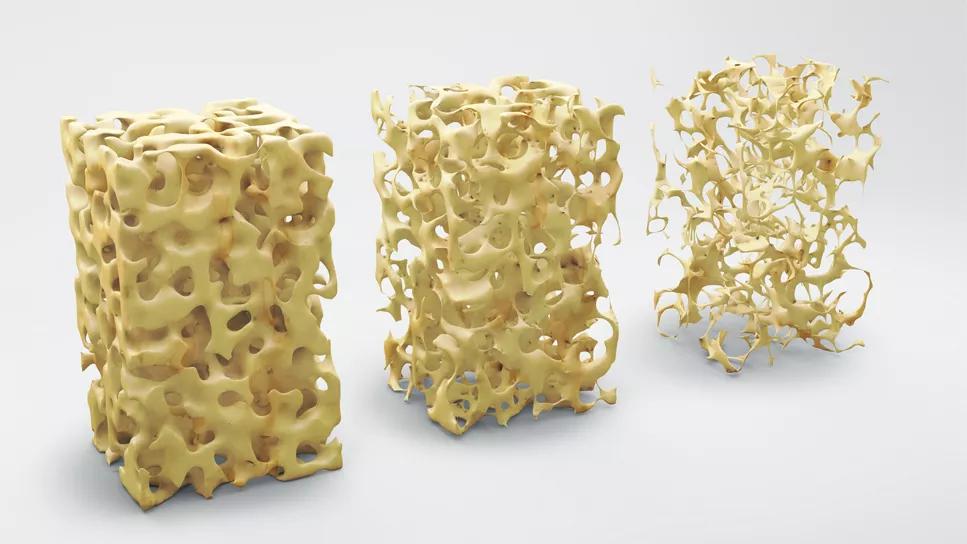Romosozumab significantly reduced fracture risk, though close follow-up is required

Advertisement
Cleveland Clinic is a non-profit academic medical center. Advertising on our site helps support our mission. We do not endorse non-Cleveland Clinic products or services. Policy
Romosozumab-aqqg/Evenity®, a new osteoporosis treatment, was approved by the U.S. Food and Drug Administration in April and will be available in the summer of 2019. This new treatment is a sclerostin inhibitor, which works through a novel (Wnt) pathway and has both anabolic and antiresorptive effects, increasing new bone formation and preventing bone breakdown. The prescribing information indicates that—if warranted—patients be continued on antiresorptive-only therapy after 12 monthly treatments.
Until now, the only anabolic medications on the market have been Teriparatide/Forteo® and Abaloparatide/Tymlos®. Romosozumab-aqqg differs from these two treatments in two important ways: it is the only treatment to build bone while having an antiresorptive effect, and it is given via in-office subcutaneous injections once monthly rather than through daily self-injections.
Pre-market trials reveal that romosozumab-aqqg significantly reduces fracture risk in postmenopausal women with osteoporosis. Patients should receive monthly romosozumab-aqqg injections for 12 months, and follow up with 12 months of an antiresorptive agent. Patients should be counseled to maintain adequate calcium and vitamin D levels via supplementation throughout treatment. Contraindications include hypocalcemia, osteonecrosis of the jaw and a cardiovascular event in the previous 12 months.
In my opinion, this is an exciting development in women’s health. Romosozumab-aqqg may be especially beneficial for women with radiation history who cannot use teriparatide or abaloparatide, or in women who already have been treated with those anabolics for the maximum 24-month period.
Advertisement
Romosozumab-aqqp has been tested in nearly 11,000 postmenopausal women in two multicenter, double-blind clinical trials. One study blindly randomized subjects to receive monthly subcutaneous romosozumab-aqqg (210 mg; N = 2,046) or weekly oral alendronate for 12 months (70 mg; N = 2,047). Both groups took weekly oral alendronate (70 mg) for the second year of the trial. Over the two-year trial, patients in the romosozumab-to-alendronate group had a 48% lower risk of new vertebral fractures than patients in the alendronate-to- alendronate group (p < 0.001). Additionally, the risk of nonvertebral fractures was 19% lower (p = 0.04) and the risk of hip fracture was reduced by 38% (p = 0.02) in the romosozumab-aqqg group compared with the alendronate group.
In another study, subjects were randomly assigned to receive subcutaneous romosozumab-aqqg (210 mg; N = 3,321) or placebo (N = 3,322) once monthly for 12 months. After the first year, all patients took denosumab (60 mg injection every six months) for 12 months. Patients taking romosozumab-aqqg had significantly reduced risks of new vertebral fractures compared with the placebo group (73% lower risk at 12 months, p < 0.001; and 75% lower risk at 24 months, p < 0.001). In this trial, adjudicated cardiovascular events were roughly evenly distributed among the trial and placebo groups.
Romosozumab-aqqg was relatively well-tolerated, with some patients experiencing injection-site sensitivity. One clinical trial of romosozumab-aqqg treatment in men with osteoporosis showed an increase in cardiac events among those patients taking romosozumab-aqqg compared with the placebo group. This possible cardiac signal resulted in a box label warning of the potentially increased risk of cardiovascular risks. Patients who have experienced a cardiovascular event in the past 12 months should not take romosozumab-aqqg. Additionally, physicians and patients should weigh the pros and cons of romosozumab-aqqg therapy in patients with cardiovascular risk factors. As with any newly approved treatment, post-marketing studies will aid in our understanding of this and other potential risks of adverse events.
Advertisement
One potential downside of romosozumab-aqqg treatment is that the injections must be administered monthly by a clinician in 2 separate vials in different sites monthly. It may prove difficult for patients to maintain the monthly regimen for 12 months. Injection timing will be especially important — if a patient is late for (or misses) her injections, she may experience rebound bone breakage. We will work with our clinical teams, including pharmacy specialists, to ensure convenient access and encourage patient adherence as the biggest concern in the field of osteoporosis is the untreated and undertreated patients.
In the United States, approximately 30% of postmenopausal women have osteoporosis and it is estimated that at least 40% of them will sustain one or more fragility fracture, according to the International Osteoporosis Foundation. My biggest concern is that osteoporosis patients are undertreated. There is a lot of misunderstanding and miseducation: osteoporosis is not a lifestyle issue that can be treated with supplements. The fact is, among people who sustain a hip fracture, approximately one-third will die, one-third will go into long-term care and one-third will recover. Given the associated morbidity and mortality, we need to start thinking of osteoporosis as a “bone attack,” similar to a heart attack.
Advertisement
Advertisement

ACOG-informed guidance considers mothers and babies

Prolapse surgery need not automatically mean hysterectomy

Artesunate ointment shows promise as a non-surgical alternative

New guidelines update recommendations

Two blood tests improve risk in assessment after ovarian ultrasound

Recent research underscores association between BV and sexual activity

Psychological care can be a crucial component of medical treatment

A multidisciplinary approach facilitates timely diagnosis and better treatment